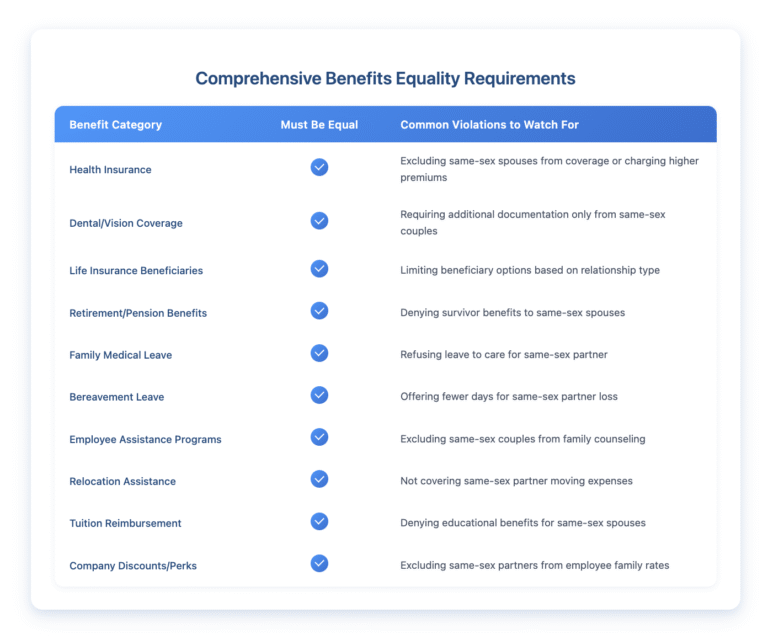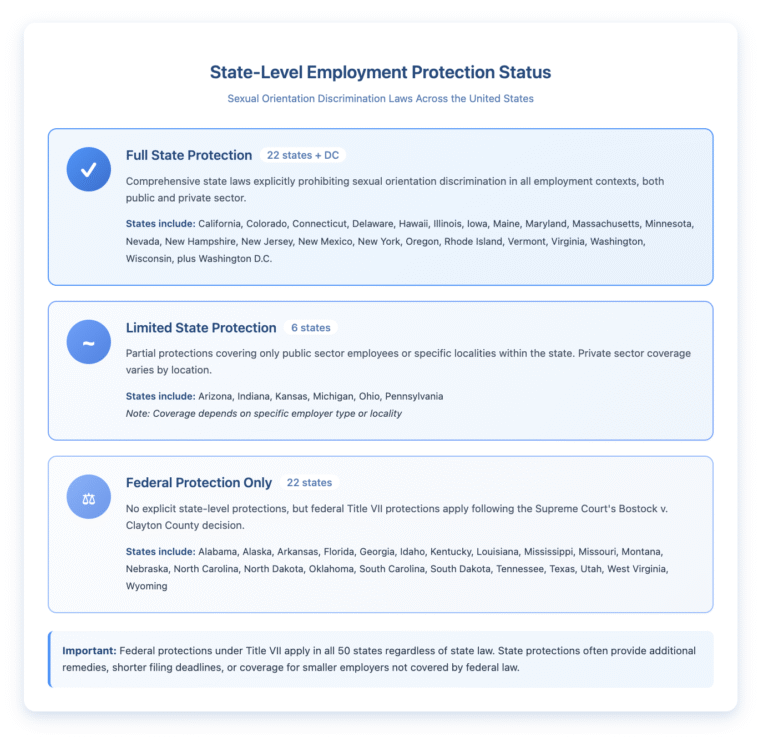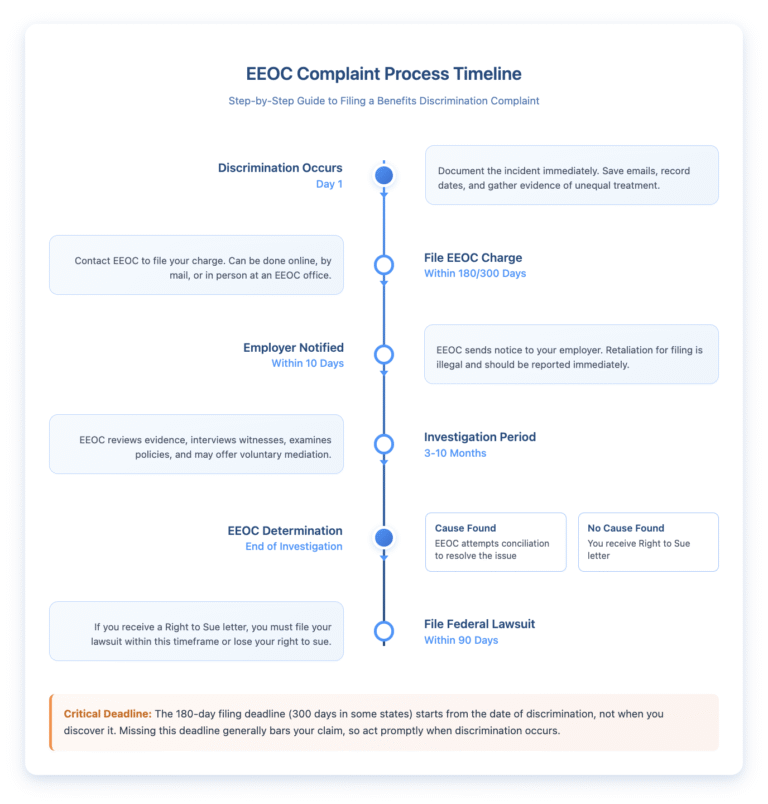If your employer offers spousal benefits to opposite-sex couples but denies them to same-sex partners, that’s not just unfair—it’s illegal. The landscape of workplace equality has shifted dramatically since the Supreme Court’s landmark decisions, yet many employees still don’t know their rights when it comes to partner benefits.
Let’s cut through the confusion and talk about what protections you actually have and how to enforce them.
Disclaimer: This article provides general information for informational purposes only and should not be considered a substitute for legal advice. It is essential to consult with an experienced employment lawyer at our law firm to discuss the specific facts of your case and understand your legal rights and options. This information does not create an attorney-client relationship.
Understanding Your Federal Rights Under Current Law
The Supreme Court’s 2020 decision in Bostock v. Clayton County fundamentally changed employment law. The Court ruled that discrimination based on sexual orientation violates Title VII of the Civil Rights Act of 1964. This means denying benefits to same-sex partners while providing them to opposite-sex partners constitutes illegal discrimination.
But here’s what many people don’t realize: this protection extends beyond just keeping your job. It covers all terms and conditions of employment, including your benefits package.
What Benefits Must Be Equal?
Your employer cannot pick and choose which benefits to offer equally. If they provide any of these benefits to opposite-sex spouses, they must provide them to same-sex spouses too:

Recognizing Discrimination: It's Not Always Obvious
Benefits discrimination doesn’t always announce itself with a policy that explicitly excludes same-sex couples. Modern discrimination often hides behind administrative hurdles and bureaucratic requirements.
For instance, requiring same-sex couples to provide “proof of domestic partnership” while automatically accepting opposite-sex marriage certificates creates an unequal burden. Even if the employer eventually provides the benefits, this additional requirement constitutes discrimination.
Documentation Requirements: The Hidden Barrier
Pay attention to what your employer asks you to provide. If you’re married to a same-sex partner and your employer requests documentation that they don’t require from opposite-sex couples, that’s a red flag.
Common discriminatory documentation practices include:
- Demanding proof of shared finances beyond what’s required of other couples
- Requiring affidavits about your relationship
- Asking for proof of cohabitation when other married couples aren’t asked
- Imposing waiting periods that don’t apply to opposite-sex couples
State Laws: Your Additional Layer of Protection
While federal law provides a baseline, many states offer even stronger protections. Twenty-two states plus Washington D.C. have explicit laws prohibiting sexual orientation discrimination in employment.

States like New York provide particularly robust protections through the New York State Human Rights Law, which explicitly covers sexual orientation and gender identity discrimination. These state laws often provide additional remedies and shorter filing deadlines, so understanding your state’s specific requirements matters.
The Marriage Recognition Factor
Since the 2015 Obergefell v. Hodges decision, all states must recognize same-sex marriages performed in any state. This means your employer cannot claim they don’t recognize your marriage because of the company headquarters location or state operations.
If you were legally married anywhere in the United States, your employer must recognize that marriage for benefits purposes, regardless of their personal, religious, or corporate beliefs.
Building Your Case: Evidence That Matters
When facing benefits discrimination, documentation becomes your strongest ally. But you need to know what evidence actually moves the needle in these cases.
Start by creating a comparison chart. Document exactly what benefits opposite-sex couples receive versus what you’re being offered or denied. Get this information in writing whenever possible—employee handbooks, benefits summaries, and email communications from HR all serve as evidence.
The Paper Trail Strategy
Every interaction about benefits should generate a paper trail. When you have verbal conversations with HR, follow up with an email summarizing what was discussed. For example:
“Thank you for meeting with me today about adding my spouse to my health insurance. As we discussed, you mentioned that I would need to provide additional documentation beyond our marriage certificate. I wanted to confirm what specific documents are required and whether this same requirement applies to all married employees.”
This approach serves two purposes: it creates evidence and often prompts employers to reconsider discriminatory practices when they see them in writing.
The EEOC Complaint Process: Your Step-by-Step Guide
Filing an EEOC complaint might seem daunting, but understanding the process removes much of the uncertainty. You have 180 days from the discriminatory act to file with the EEOC (300 days in states with their own fair employment agencies).

What Happens During the Investigation?
Once you file, the EEOC will notify your employer within 10 days. The investigation typically includes:
- Review of your submitted documentation
- Requests for information from your employer
- Interviews with relevant witnesses
- Analysis of company policies and practices
- Comparison with how other employees are treated
The EEOC might also offer mediation—a faster, less adversarial process where a neutral mediator helps both parties reach an agreement. Mediation is voluntary and confidential, and it doesn’t prevent you from pursuing other options if unsuccessful.
Recent Legal Developments Strengthening Your Position
The legal landscape continues to evolve in favor of equality. In 2021, President Biden signed Executive Order 14021, which specifically addressed discrimination against LGBTQ+ federal employees and contractors.
The EEOC has also issued updated guidance clarifying that employers cannot cite religious beliefs as a blanket excuse to deny equal benefits. While religious organizations have some exemptions, most private employers cannot use religion to justify benefits discrimination.
The Insurance Company Excuse: Why It Doesn’t Hold Water
Some employers claim their insurance company doesn’t offer same-sex partner coverage. This excuse doesn’t absolve them of legal responsibility. Employers must either find insurance that provides equal coverage or self-fund the difference to ensure equality.
The U.S. District Court for the Northern District of Illinois addressed this directly in Hively v. Ivy Tech Community College, noting that administrative inconvenience or increased costs don’t justify discrimination.
Practical Steps You Can Take Today
If you’re facing benefits discrimination, taking action doesn’t have to wait. Here’s what you can do right now:
Immediate Actions Checklist
- Request your complete benefits package in writing – Include all policy documents, not just summaries
- Document the discrimination – Save emails, record dates of conversations, keep notes of what was said
- Find a comparator – Identify an opposite-sex couple at your workplace receiving the benefits you’re denied
- Review your employee handbook – Look for equal opportunity statements and complaint procedures
- Check your state’s laws – Some states have shorter filing deadlines or additional protections
- Preserve all communications – Don’t delete emails or texts, even if they seem unimportant
Know Your Internal Options
Before filing with the EEOC, explore your company’s internal complaint process. Many employers have HR procedures for addressing discrimination. Using these channels creates additional documentation and might resolve the issue faster.
However, using internal procedures doesn’t extend your EEOC filing deadline, so keep track of time limits while pursuing internal remedies.
When Retaliation Becomes a Concern
Federal law prohibits employers from retaliating against you for asserting your rights to equal benefits. Retaliation can include:
- Sudden negative performance reviews
- Exclusion from meetings or projects
- Schedule changes or transfer to less desirable positions
- Increased scrutiny or impossible deadlines
- Hostile treatment from supervisors
Document any changes in how you’re treated after raising benefits concerns. Retaliation claims often succeed even when the underlying discrimination claim faces challenges.
The Financial Impact: What You Stand to Gain
Beyond the principle of equality, benefit discrimination has real financial consequences. Health insurance alone can be worth thousands of dollars annually. When you factor in dental, vision, life insurance, and retirement contributions, the total value often exceeds $15,000 per year.
In successful discrimination cases, courts have awarded:
- Back pay for lost benefits value
- Compensatory damages for emotional distress
- Punitive damages in cases of willful discrimination
- Attorney’s fees and legal costs
- Injunctive relief requiring policy changes
Moving Forward: Your Rights Are Clear
The law is firmly on your side when it comes to same-sex partner benefits equality. Federal protections under Title VII, combined with state laws and recent legal precedents, create a strong framework for challenging discrimination.
Remember, seeking equal benefits isn’t asking for special treatment—it’s demanding the same treatment your colleagues already receive. The days of employers legally denying benefits based on sexual orientation are over.
Taking the Next Step
If you’re experiencing benefits discrimination, you don’t have to navigate this alone. Document everything, know your deadlines, and understand that the law provides powerful tools to fight discrimination.
Whether you’re dealing with outright denial of benefits, facing additional requirements, or encountering subtle forms of discrimination, you have options. The key is acting within the legal timeframes and building a strong case through documentation.
Contact Nisar Law for a consultation about your benefits discrimination case. With the right legal strategy and the current state of the law on your side, you can secure the equal treatment you deserve. Don’t let discrimination cost you thousands in benefits you’re legally entitled to receive.
Your relationship is valid. Your marriage is recognized. And your right to equal benefits is protected by law.


